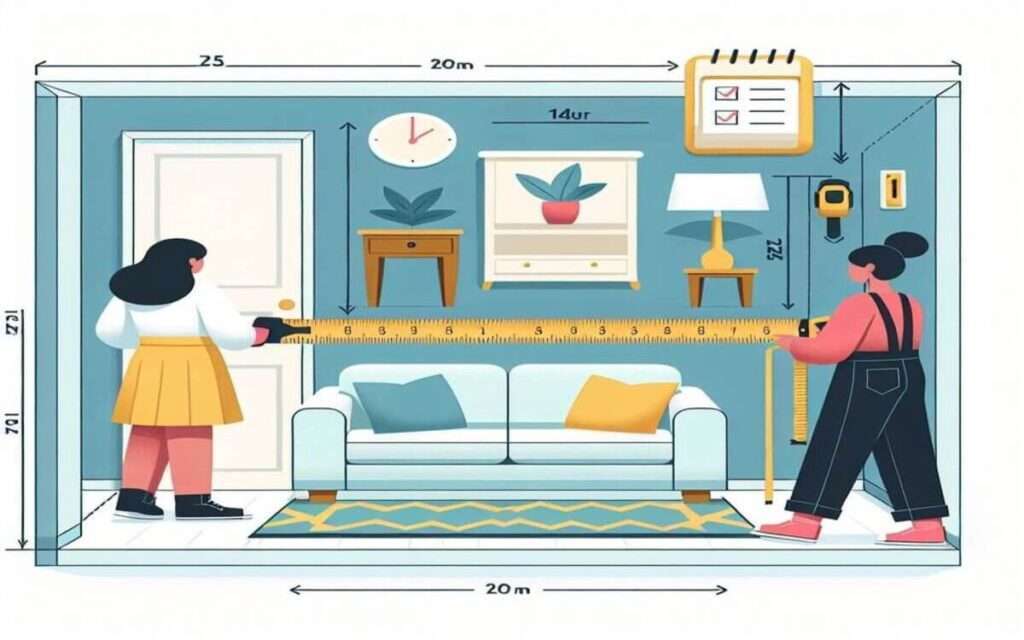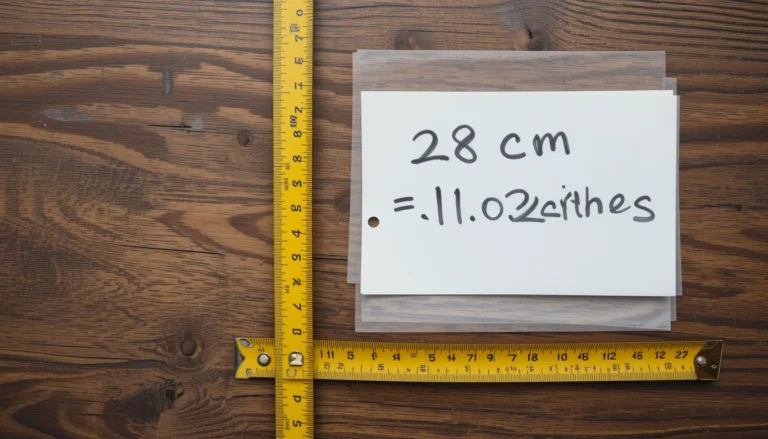Understanding a room’s exact dimensions is critical when setting up a room. This knowledge ensures that your furniture layout is both functional and visually appealing. Whether you’re moving into a new space or rearranging an existing one, knowing how to measure room dimensions helps you maximize your area and avoid costly design mistakes.
In this guide, we’ll walk you through every step of measuring, from identifying key features like windows and doors to planning the placement for optimal flow.
As someone who has worked as an interior designer for many years, I’ve learned that having the right measurements is essential. Early in my career, I realized that those numbers would be useful throughout the project after the design has been completed. So, before you buy any furniture or start making plans, ensure you save your measurements for easy reference when shopping later on.
Why Accurate Room Measurements Are Crucial for Furniture Layout
Before you can even consider choosing furniture, it’s essential to understand the size and shape of your room. Accurate measurements provide the foundation for a functional layout, ensuring that every piece fits perfectly without overcrowding or leaving too much open space. This creates an aesthetically pleasing environment and promotes better flow, allowing you to move around comfortably.
Precise measurements can help you avoid common mistakes, such as buying furniture that is too large for the space or placing pieces that block doorways and windows. Ultimately, understanding your room’s exact dimensions ensures you make the most out of your area, regardless of its size. This careful planning leads to a harmonious and usable space, making your home a more enjoyable place to live.
Tools You’ll Need for Measuring Room Dimensions
Before starting the measurement process, make sure you have the following tools: a measuring tape; a standard one will work well, but a laser measure can provide even more accuracy. You’ll also need a pen and paper or a digital sketching app to create a rough sketch and mark your measurements as you go.
Additionally, a level is useful if you plan to install items on the walls, as it ensures everything is straight and accurate. Having a helper is optional, but having someone hold one end of the tape can make the process easier, especially in larger rooms. These tools will help you gather precise dimensions and facilitate a smooth furniture layout process.
Preparing for Measurement: Steps to Maximize Accuracy

To get the most precise measurements, it’s essential to clear the room as much as possible. Remove large items like furniture and decor that may obstruct your ability to measure wall-to-wall. If you cannot move certain pieces, work around them, making a note to revisit those areas later. This preparation not only ensures more accuracy but also gives you a clear picture of the entire space, helping you better visualize where different items might fit.
Before you start measuring, take a moment to identify any potential obstacles such as columns, alcoves, or irregular shapes that could impact your furniture placement. These architectural details will need to be factored into your plan accordingly. For example, spots with built-in shelves can limit larger items, and partial walls may divide functional zones, separating the dining area from the living space.
Identifying fixed features like windows, doors, and built-ins is one of the most important steps in measuring for your layout. Knowing their exact positions and dimensions is crucial, so be sure to measure both the width and height, as well as how much clearance you will need. Also, account for how far doors swing open, as this affects where you can place furniture without blocking pathways.
A Detailed Guide to Accurate Room Measurements

Measuring a room accurately is an essential part of planning your furniture layout. Here’s a step-by-step approach to ensure you capture all necessary dimensions.
1. Sketching the Room Layout on Paper
Once your room is cleared and you have a good sense of the layout, it’s time to create a rough sketch. Drawing a simple floor plan will help you keep track of your measurements and visualize the space as you work. You don’t need to be an artist; just outline the walls, doors, windows, and any other features like radiators or built-in shelves.
Start by marking the dimensions of the room on your sketch. Then, indicate the positions of fixed features, ensuring they are to scale. This visual representation will guide you in determining where different furniture pieces might fit best. By having this basic drawing, you can easily experiment with various layouts and arrangements, making it easier to design a functional and aesthetically pleasing space.
2. Measuring the Length and Width of the Room
Using a measuring tape, measure the length and width of the room by placing the tape along the floor from one wall to the opposite. For better accuracy, measure at multiple points in case the walls aren’t perfectly straight. Record each measurement on your sketch.
Begin by measuring one wall, making sure the tape is straight and flat against the floor. Then, move to the opposite walls and repeat. Ensure all these dimensions are clearly noted on paper or in a digital sketching app. This will provide a solid foundation for planning your furniture layout and making informed decisions about the space.
3. Measuring the Height of the Ceiling
Don’t forget the vertical dimension when measuring your room. Measure the height of the ceiling by placing the tape from the floor to the ceiling at several points around the room. This is particularly important if you plan to install tall furniture or shelving units that need sufficient clearance.
Recording these measurements will help ensure that your taller pieces fit comfortably without overwhelming the space or obstructing any architectural features.
4. Measuring Doors and Door Swings
When measuring doors, make sure to note both their height and width. Additionally, pay attention to how far the door swings into the room, as this can impact your layout options. Mark the door’s position on your sketch, along with the direction it swings open.
Be sure to leave enough clearance when placing furniture nearby to avoid blocking the door’s movement. Knowing the exact dimensions and swing of the doors helps you plan more effectively, ensuring the room remains functional and comfortable.
Following these steps carefully will help you gather all the information you need to create a well-planned furniture layout that maximizes both functionality and aesthetics in your space.
Measuring for Furniture Placement
When measuring for furniture placement, it’s crucial to determine the right scale of furniture for the size of your room. Placing furniture requires understanding how pieces fit within the space. Large items like sofas or beds can overwhelm a room, while smaller pieces can get lost in a large area.
For a sofa, which is often the centerpiece of living rooms, measure the width and compare it to the wall where it will be placed. Ensure there’s enough clearance around the sofa for walking space. Similarly, when measuring for dining tables and chairs, account for the dimensions of the table and leave enough room for chairs to be moved comfortably. A general rule of thumb is to allow 36 inches between the table and the nearest wall or furniture for easy seating movement.
In bedrooms, measure the bed frame and headboard to ensure they fit against the wall, and leave space for nightstands and walking paths. Don’t forget to measure other items like dressers and wardrobes to ensure they fit comfortably in the space without blocking movement. These precise measurements help you create a balanced, functional layout that works for your room.
Common Mistakes to Avoid
1. Overcrowding the Room with Furniture
One of the most common mistakes is filling the room with too much furniture. Overcrowding not only makes the room feel smaller but also disrupts the flow. Focus on choosing a few key pieces and leave space for movement.
2. Forgetting to Measure Vertical Space for Tall Furniture
When measuring for taller pieces, like bookshelves or armoires, don’t forget to account for vertical space. Measure the height of your ceiling and compare it to the height of the furniture to avoid blocking light fixtures or making the room feel cramped.
3. Ignoring the Impact of Door Swings on Layout
Always remember to factor in door swings when planning your layout. Doors that swing into the room need sufficient clearance, so you don’t want to place furniture too close to them.
Conclusion
Accurately measuring your room is a crucial first step in creating a functional and aesthetically pleasing furniture layout. Start by gathering the right tools, clearing the space, and sketching a basic floor plan. Measure the length, width, and height of the room, along with the positions of doors, windows, and other fixed features like radiators and built-ins. Be sure to account for door swings, clearance around windows, and the placement of electrical outlets.
As you measure for furniture placement, consider how the size and scale of each piece will fit into the room without crowding or leaving too much empty space. By following these steps, you’ll ensure that your furniture fits seamlessly into the room, creating a comfortable and visually appealing environment.
If you enjoy to explore dimensions, then start reading the detailed World Dimension Explorer blog post.
Let’s Explore >> How Large is Earth in Kilometers and Miles? Explore Earth’s Dimension
Frequently Asked Questions
1. Why is it important to measure room dimensions before buying furniture?
Measuring room dimensions helps ensure that the furniture you choose fits well within the space, preventing overcrowding or awkward arrangements. Accurate measurements allow for a more functional layout and can save you from costly mistakes.
2. How much clearance should I allow around furniture?
A good rule of thumb is to allow at least 36 inches of clearance between the edges of furniture (like tables) and walls or other furniture pieces. This ensures comfortable movement and access within the space.
3. Can I measure furniture dimensions online?
Yes, many furniture retailers provide detailed dimensions of their products online. However, it’s always best to physically measure your space to ensure a perfect fit, as online measurements may not account for your room’s specific layout.
4. What should I consider when measuring for larger furniture like sofas and beds?
For larger furniture, ensure you measure not only the dimensions of the pieces but also the available space. Consider the height of the room, the width of doorways for entry, and how the furniture will affect traffic flow within the room.
5. How do I measure windows for furniture placement?
Measure the width and height of each window, noting how far they are from the floor and ceiling. This information is crucial for determining the placement of furniture like sofas or dressers to avoid blocking natural light.
6. What are common mistakes to avoid when measuring a room?
Common mistakes include not measuring multiple points (which can lead to inaccuracies if walls aren’t straight), failing to account for obstacles, and neglecting to double-check measurements before making furniture purchases.











